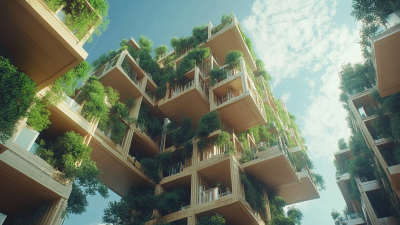Natural beauty for your favorite space
Advantages of Choosing Sustainable Construction Materials for Global Buyers
The construction industry is at a pivotal crossroads where the choice of materials significantly impacts both project outcomes and the environment. According to a report by the World Green Building Council, the building sector accounts for over 39% of global carbon emissions, emphasizing the urgent need for sustainable practices. By opting for Environmentally Friendly Building Materials, buyers can significantly reduce their carbon footprint while also complying with increasing regulations aimed at environmental protection. This shift not only promotes ecological balance but also enhances the overall quality and longevity of the structures being built.
Moreover, sustainable construction materials can lead to substantial economic benefits. The U.S. Green Building Council notes that green buildings can save 30% or more on energy costs, providing a compelling case for stakeholders. Investing in Environmentally Friendly Building Materials not only fulfills a moral obligation to protect our planet but also opens doors to innovative design solutions and potential long-term savings in maintenance and operational costs. As global buyers become more conscious of their choices, the transition toward sustainable construction is not only preferable but necessary for sustainable development.

Benefits of Sustainable Construction Materials: A Global Perspective
Sustainable construction materials are becoming increasingly vital for global buyers looking to minimize their environmental impact while ensuring robust and durable structures. One of the primary benefits of choosing these materials is the reduction of carbon footprints. Traditional construction materials often involve high energy consumption and greenhouse gas emissions during production and transport. In contrast, sustainable alternatives, such as bamboo, recycled steel, and reclaimed wood, utilize fewer resources and can often be sourced locally, significantly lowering the associated environmental costs.
In addition to their ecological advantages, sustainable construction materials are known for their long-term economic benefits. Although they may have a higher initial cost, these materials contribute to energy efficiency and reduce maintenance expenses over time. Buildings constructed with sustainable materials often have superior thermal performance, leading to decreased energy bills. Furthermore, many clients and regulatory bodies are now prioritizing green building certifications, which can enhance property value and attractiveness in an increasingly eco-conscious marketplace.
The aesthetic and health benefits of sustainable materials also cannot be overlooked. Many natural materials not only provide a unique and appealing look but also contribute to healthier indoor environments by reducing exposure to harmful chemicals found in synthetic building products. Increasingly, architects and builders are opting for sustainable options to create spaces that promote well-being while still meeting the functional needs of their occupants. By embracing sustainable construction materials, global buyers are not just making a choice for the present but are investing in a more sustainable future.
| Advantage | Description | Stakeholder Impact |
|---|---|---|
| Environmental Benefits | Reduces carbon footprint and minimizes waste. | Beneficial for local communities and ecosystems. |
| Economic Savings | Long-term cost savings through energy efficiency and durability. | Helps businesses reduce operational costs. |
| Healthier Spaces | Promotes better indoor air quality and reduces toxins. | Improves well-being for occupants and workers. |
| Regulatory Compliance | Adheres to increasing global sustainability standards. | Ensures competitiveness in the market. |
| Enhanced Brand Image | Attracts eco-conscious consumers and investors. | Strengthens brand loyalty and market position. |
The Economic Impact of Sustainable Materials on Construction Budgets
The economic impact of sustainable materials on construction budgets is substantial, as these materials often lead to long-term savings despite higher initial costs. According to a 2021 report by the World Green Building Council, buildings constructed with sustainable materials can reduce operational costs by up to 20%. This reduction is primarily due to the improved energy efficiency these materials provide, decreasing reliance on heating and cooling systems. As regulatory pressure increases on builders to meet sustainability criteria, integrating eco-friendly materials becomes not only beneficial for the environment but financially savvy for construction firms.
Moreover, investing in sustainable construction materials can enhance a project's marketability. A study by McGraw Hill Construction indicated that 36% of contractors believe that sustainable building practices without compromising quality lead to higher profit margins. This perception is critical in an increasingly eco-conscious consumer market, where buyers are willing to pay more for properties built with sustainability in mind. By positioning a project as environmentally friendly, developers can tap into this growing demand, thereby improving sales and overall returns on investment.
In addition, the use of sustainable materials can reduce waste management costs significantly. According to a report by the Materials Recovery Facility, construction and demolition waste can constitute up to 30% of landfill content. Utilizing sustainable materials often means sourcing from recycled or rapidly renewable resources, aligning construction practices with circular economy principles. This not only minimizes disposal costs but also mitigates the financial risks associated with potential regulatory penalties for excess waste. Thus, opting for sustainable materials can directly enhance a project's bottom line while fostering a more responsible approach to development.
Environmental Benefits: Reducing Carbon Footprint in Construction
The construction industry is one of the largest contributors to global carbon emissions, accounting for approximately 38% of total energy-related CO2 emissions according to a 2021 report by the Global Alliance for Buildings and Construction. By opting for sustainable construction materials, global buyers can play a pivotal role in mitigating environmental impact and reducing the carbon footprint associated with building projects.
Sustainable materials such as reclaimed wood, recycled steel, and low-VOC (volatile organic compounds) products not only help in lowering emissions but can also lead to enhanced energy efficiency during the building lifecycle. The use of recycled materials can reduce the demand for virgin resources, and studies show that recycling steel can save up to 74% of the energy used in producing new steel. Furthermore, the incorporation of sustainable insulation materials can improve thermal performance, leading to reduced heating and cooling requirements and significant energy savings over time.
Moreover, structural designs that utilize sustainable materials tend to generate less waste during construction and promote a circular economy. According to a 2020 study by McKinsey, adopting circular economy principles could reduce global emissions by up to 45% by 2030. By choosing sustainable options, global buyers contribute to creating a greener built environment, which not only addresses climate change but also enhances social well-being through improved air quality and healthier living conditions.

Enhanced Durability and Longevity: The Case for Sustainable Options
Sustainable construction materials are gaining popularity among global buyers, not only for their environmental benefits but also for their superior durability and longevity. When considering construction projects, the choice of materials can significantly impact the lifespan of structures. Sustainable options, such as recycled steel, bamboo, and other eco-friendly products, offer exceptional strength and resilience that often surpass traditional materials.
One of the key advantages of sustainable materials is their resistance to environmental stressors. For instance, materials like reclaimed wood and recycled plastics can withstand moisture, pests, and UV exposure much better than their conventional counterparts. This increased resistance translates to reduced maintenance costs and fewer repairs over time, making them a cost-effective solution in the long run. Therefore, buyers seeking to maximize their investment will find that opting for sustainable options pays off through enhanced durability.
Moreover, many sustainable materials have a lower carbon footprint during production, which contributes to their overall longevity. Innovations in technology have allowed for the creation of products that not only meet durability standards but also minimize environmental impact. This harmonization of strength and sustainability is becoming a crucial factor for buyers looking to align their projects with modern ecological values, ultimately leading to a more resilient built environment tailored for the future.
Advantages of Choosing Sustainable Construction Materials
This chart illustrates the enhanced durability and longevity of sustainable construction materials compared to traditional materials, highlighting their advantages for global buyers.
Consumer Preferences and Market Trends in Sustainable Building Practices
In recent years, the landscape of the construction industry has experienced a significant transformation, driven by a growing consumer demand for sustainable practices and materials. As global awareness of environmental issues rises, buyers are increasingly prioritizing sustainability when selecting construction materials. This shift is not just a trend; it's becoming a baseline requirement for many consumers, who are now actively seeking out eco-friendly options that align with their values.
The market for green building materials reflects this changing consumer preference. Forecasts indicate that the global market is set to exceed USD 580 billion by 2029, up from USD 322.48 billion in 2023. This dramatic growth underscores the pivotal role of sustainability in the construction sector. As environmental concerns escalate and regulatory measures become more stringent, businesses that embrace sustainable practices will not only meet consumer expectations but also position themselves for long-term success.
Furthermore, the rise of the wellness movement has intertwined with sustainable construction practices, as more consumers opt for products that enhance their quality of life while minimizing environmental impact. This intersection of wellness and sustainability is reshaping home construction, leveraging new materials and technologies that promise both aesthetic appeal and ecological responsibility. In this rapidly evolving market, those who adapt to these consumer-driven trends will lead the way in defining the future of construction.
Advantages of Choosing Sustainable Construction Materials
This chart illustrates the advantages of choosing sustainable construction materials according to consumer preferences. The largest segment, "Environmentally Friendly," highlights the top priority for global buyers, followed by "Cost-Effective" and "Durability." Understanding these preferences can help guide market trends in sustainable building practices.
Related Posts
-

Advantages of Choosing Eco Building Products for Sustainable Construction Solutions
-

Envisioning Tomorrow: Innovative Perspectives on Sustainable Building Materials in Architecture
-

Exploring the Advantages of the Most Eco-Conscious Construction Materials
-

Exploring the Future of Sustainable Building Products for Global Procurement Success
